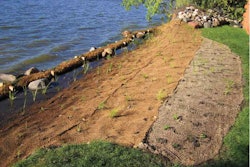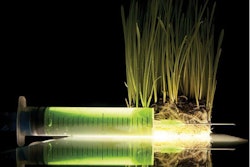The Grass Revolution
What: Battle lines are being drawn across the country over lawn management practices.
Why: Lawns account for up to 50 percent of residential water use in some areas, and government conservation efforts and environmental groups are pressing for change.
Bottom Line: Water management may become the single biggest challenge for landscapers in the near future, and those who are savvy on the subject stand to profit.
There is a revolution brewing regarding lawn management in America. And the battlegrounds encompass every patch of hallowed green grass found in every state in the Union. You could say the battle began back in 1981 when the Denver Water Planning Division began promoting “Xeriscaping” as an approach to water-wise landscaping. This movement continues to grow today, and the major brunt is turf. Before dismissing the notion as rantings from a bunch of tree-huggers, take a closer look. You may have more in common with these groups than you think.
“To the professional, I would say lawn care reform offers the opportunity to increase your business dramatically.”
“In this big country, there are widely disparate views of lawns, from that of downright contempt to viewing them as God’s gift to lawnmower manufacturers,” says Saxon Holt, garden photographer and coauthor of The American Meadow Garden. Holt is a member of the Lawn Reform Coalition (LRC), a group of environmental advocates from across the country who want to promote changes in the American lawn. The group is dedicated to pooling their knowledge of up-to-date solutions to problems caused by a lawn culture demanding excessive water, fertilizer and pesticides and spreading the word via their blogs, Websites and other media.
“Lawn Care Reform is not anti-lawn or about eliminating lawns, but more about the appropriate use of the ground around our homes and business parks,” Holt says. “These cultivated grounds are precious, and LRC wants to reform the blind and unimaginative assumption that lawns are the best way to use the land around us.”
Holt believes many landscapers are missing the boat when it comes to lawn care reform. “This has huge business potential if existing professionals could help lead the way and expand their knowledge.”
Another LRC member, professional horticulturist Thomas Christopher, agrees lawn reform offers great opportunities for imaginative and adaptable landscapers. “As the need for conserving water and reducing the use of fossil fuels increases, our traditional reliance on poorly adapted, resource-intensive types of turf grasses will have to change,” he says. “Landscapers who can provide their customers with alternatives will find themselves much in demand.”
Rather than trashing grass, Christopher has been promoting new cultivars of fine fescue in his area of Connecticut. “These fine fescues require only three to four mowings a year and thrive in my region without summer irrigation, and with less fertilization than traditional turfs,” he says. “Fine fescues are not a panacea. But, they illustrate the alternatives available to enterprising landscapers.”
Cashing In
Gene Ebertowski, a TLC 2011 Landscaper of the Year finalist and owner of FloraTerra Landscape Management based in San Jose, California, says he’s working 12-hour days to keep up with the demand for clients who want his eco-friendly landscape services.
“Water conservation is the single most important challenge to the future of landscape management,” he says. “We keep certified water managers and auditors on staff. New irrigation system technology and rebates from local water authorities make water conservation more affordable than ever.” He says his company appeals to clients who want to avoid water waste and overuse penalties, meet water allocations, save money and achieve points toward LEED certification.
FloraTerra’s design team focuses on choosing low-water-use plant alternatives, converting older lawns to seasonally flowering, drought tolerant, insect and disease resistant shrubs, trees and ornamental grasses. “We often convert inefficient overhead spray irrigation to efficient drip irrigation systems,” Ebertowski says. “Smart irrigation controllers apply water to current ET [evapotranspiration] rates in the precise amounts of water needed to keep plant material vibrant and healthy through changing seasonal weather patterns. This results in sustainable landscapes that are attractive, last a long time, save water and use less fertilizer and pesticides to maintain.”
Other Side of the Coin
The Outdoor Power Equipment Institute (OPEI), an international trade association representing the $15 billion landscape, lawn and garden, forestry and utility equipment manufacturing industry, promotes turf as a valuable asset that shouldn’t be regulated away. But much like the LRC, OPEI wants to see landscapers make the best plant choices. After all, water-starved, weedy turf does not reflect well on the industry.
“We need to educate consumers about selecting the right plant, for the right spot and for their climate,” says Kris Kiser, executive vice president at OPEI. “We have hard science showing turf grass has value when it comes to the ability to absorb carbon dioxide, release oxygen, cool the air, control dust, reduce erosion and filter water. However, to minimize inputs, consumers need to find grasses that work well in their climate zone.”
Cash for Turf
Cash for grass replacement programs are offered by a growing number of water districts, primarily in California, Arizona, New Mexico, Nevada and Texas. Typically, customers fill out an application and allow a water district inspector to visit the site to document the amount of existing turf. After removing turf and converting it to approved drought-tolerant plants, the site is re-examined and a rebate (typically between 20 cents and $1.50) for every square foot converted is sent to the property owner. Some programs also require installation of updated efficient irrigation.
Yet, in a report for the Turf Resource Center, Sylvan Addink, Certified Professional Agronomist, concluded the benefits of the cash-for-grass programs come more from installing and maintaining proper irrigation, rather than simply removing turf. He writes, “Based on water application rates on tall fescue plantings [in Las Vegas], a water savings of 28 percent could have been achieved by applying only the amount of water required by the tall fescue plants. The Southern Nevada Water authority, in their summer 2004 Waterwise publication, stated that, ‘On average, residents use 40 percent more water on their grass than most turf requires.’”
Turf by the Numbers
50% Amount of residential water applied to landscapes, according to Xeriscape Colorado
60% Amount of water a typical Xeriscape irrigation/landscape system saves the average property owner, according to Xeriscape Colorado.
23 million gallons Resulting water savings when 385 participants in a cash-for-grass program in El Paso, Texas, converted 29 acres of turfgrass to Xeriscape, according to El Paso Water Utility.
2 million gallons Amount of irrigation water per year Harvard University has reduced (30 percent) since converting to organic lawn care.
50’ x 50’ – turf area needed to produce enough oxygen to meet the everyday needs of a family of four (source: www.turfgrasssod.org)
1 acre – area of turf needed to produce enough oxygen for 64 people a day. (source: www.turfgrasssod.org)
80% – the amount of weeds and disease the EPA estimates can be eliminated by using the correct mowing height for a given turf.
Eco-friendly Lawn Care Tips
1. Plant climate-appropriate grasses and grass-like species. Drought-tolerant doesn’t mean dull when it comes to planting.
2. Shade lawn from hot, midsummer sun.
3. Use redirected drainspouts and/or bermed plantings to direct runoff to the lawn area.
4. Add organic matter such as grass clippings and chopped leaves to lawn, and aerate compacted soil so it can absorb more moisture, which makes the lawn more drought-tolerant.
5. Use evapotranspiration controllers (ET or smart controllers), a self-adjusting controller that automatically adjusts irrigation schedules based on specific landscape needs and local weather conditions.











